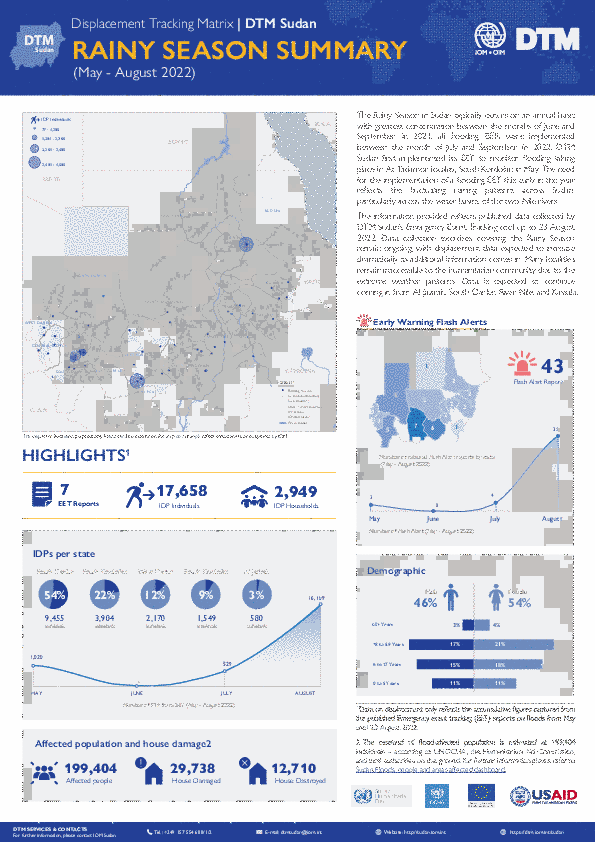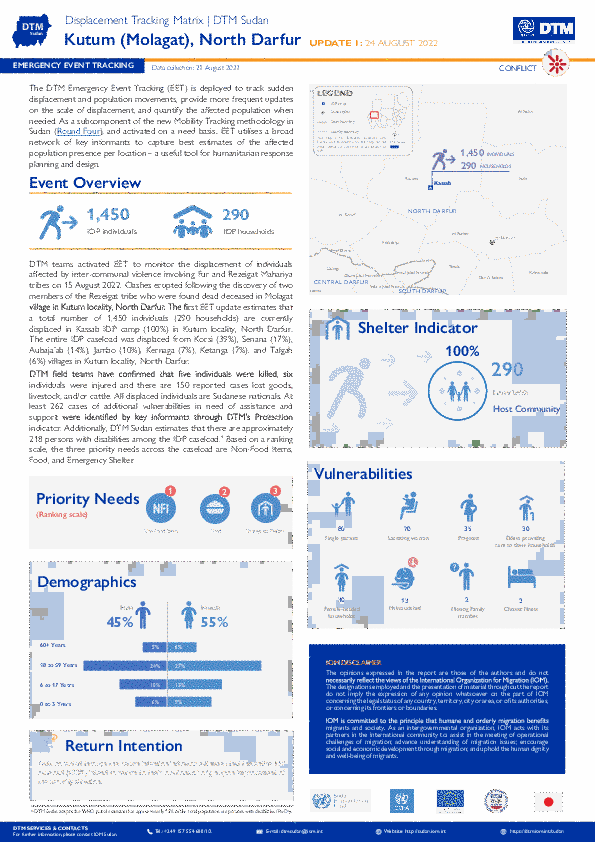-
Countries
-
Data and Analysis
-
Special Focus
-
Crisis Responses

Contact
Regional Office Dakar, RODakar-DataResearch@iom.int, DTMBurkinaFaso@iom.int
Language
French
Location
Burkina Faso
Period Covered
Jul 01 2022
Jul 31 2022
Activity
- Flow Monitoring
Afin de mieux comprendre les mouvements et tendances migratoires en Afrique de l’Ouest et du Centre, l’OIM, à travers la Matrice de suivi des déplacements (Displacement Tracking Matrix, DTM), met en œuvre l’activité de Suivi des flux de populations (Flow Monitoring, FM).
Au Burkina Faso, la DTM recueille des données au niveau de 4 Points de suivi des flux (Flow Monitoring Points, FMP) que sont Dori/Seytenga, Kantchari, Faramana et Yendéré répartis dans 4 régions afin d’obtenir une meilleure compréhension de l’ampleur, des tendances, des caractéristiques socio-démographiques et des parcours des flux de voyageurs traversant ces différents points.
Ce rapport présente les données recueillies dans le cadre des activités d’enregistrement des flux durant le mois de Juillet 2022.

Contact
dtmhaiti@iom.int
Language
English
Location
Haiti
Period Covered
Aug 20 2022
Aug 26 2022
Activity
- Event Tracking
690 nouveaux déplacements et 1 411 nouvelles arrivées de personnes déplacées internes ont été rapportés pendant la période d’évaluation dans les 316 quartiers évalués. La plupart de ces déplacements ont eu lieu dans les communes de Cité Soleil (quartiers de Projet Drouillard et Brouklin) et Croix-Des-Bouquets (quartier de Corail - Jerusalem). En matière de sécurité, la situation reste toujors tendue, avec 29 quartiers affectés par des violences généralisées et sept par des violences ciblées. 30 quartiers ont été touchés par des innondations, une situation aggravée par le mauvais état des infrastructures de canalisation dans la ZMPP. Durant la période d’évaluation du 13 au 19 août, la DTM estimait 283 nouveaux déplacements et 723 nouvelles arrivées de personnes déplacées dans les 341 quartiers évalués.

Contact
DTM Sudan; dtmsudan@iom.int
Language
English
Location
Sudan
Snapshot Date
Aug 17 2022
Activity
- Mobility Tracking
- Event Tracking
The DTM Emergency Event Tracking (EET) is deployed to track sudden displacement and population movements, provide more frequent updates on the scale of displacement, and quantify the affected population when needed. As a subcomponent of the new Mobility Tracking methodology in Sudan (Round Four), and activated on a need basis, EET utilises a broad network of key informants to capture best estimates of the affected population presence per location – a useful tool for humanitarian response planning and design.

Contact
dtmsudan@iom.int
Language
English
Location
Sudan
Period Covered
Jan 01 2022
Aug 22 2022
Activity
- Mobility Tracking
- Event Tracking
The Rainy Season in Sudan typically occurs on an annual basis with greatest concentration between the months of June and
September. In 2021, all flooding EETs were implemented between the month of July and September. In 2022, DTM Sudan first implemented its EET to monitor flooding taking place in At Tadamon locality, South Kordofan in May. The need for the implementation of a flooding EET this early in the year reflects the fluctuating raining patterns across Sudan, particularly across the water basins of the two Nile rivers.
The information provided reflects published data collected by DTM Sudan’s Emergency Event Tracking tool up to 23 August
2022. Data collection exercises covering the Rainy Season remain ongoing, with displacement data expected to increase
dramatically as additional information comes in. Many localities remain inaccessible to the humanitarian community due to the
extreme weather patterns. Data is expected to continue coming in from Al Jazirah, South Darfur, River Nile, and Kassala.

Contact
DTM Yemen, iomyemendtm@iom.int
Language
English
Location
Yemen
Period Covered
Jan 01 2022
Jun 30 2022
Activity
- Mobility Tracking
Eight years of conflict have led to a precarious humanitarian situation the Yemen in terms of displacement, political instability,
severe economic decline, food insecurity/risk of famine and a collapse of essential public services. The internationally recognized
government (IRG) and the de facto authorities (DFA) agreed to an UN-brokered two-month truce signed in April 20221 which
has led to improvements in political stability, decrease in armed conflict and a reduction in civilian casualties by two thirds
compared to prior three months. The decrease in conflict in parts of the country since April has led to a decrease in new instances
of displacement compared to the last months of 2021.

Contact
DTM Sudan; dtmsudan@iom.int
Language
English
Location
Sudan
Snapshot Date
Aug 21 2022
Activity
- Mobility Tracking
- Event Tracking
The DTM Emergency Event Tracking (EET) is deployed to track sudden displacement and population movements, provide more frequent updates on the scale of displacement, and quantify the affected population when needed. As a subcomponent of the new Mobility Tracking methodology in Sudan (Round Four), and activated on a need basis, EET utilises a broad network of key informants to capture best estimates of the affected population presence per location – a useful tool for humanitarian response planning and design.

Contact
DTM Sudan; dtmsudan@iom.int
Language
English
Location
Sudan
Snapshot Date
Aug 21 2022
Activity
- Mobility Tracking
- Event Tracking
The DTM Emergency Event Tracking (EET) is deployed to track sudden displacement and population movements, provide more frequent updates on the scale of displacement, and quantify the affected population when needed. As a subcomponent of the new Mobility Tracking methodology in Sudan (Round Four), and activated on a need basis, EET utilises a broad network of key informants to capture best estimates of the affected population presence per location – a useful tool for humanitarian response planning and design.

Contact
dtmvzaresponse@iom.int
Language
Spanish
Location
Panama
Period Covered
Jul 07 2022
Jul 15 2022
Activity
- Flow Monitoring Survey
- Flow Monitoring
Ante la necesidad de conocimiento de las características y patrones de movilidad de personas en tránsito por la provincia de Darién, OIM implementa una Encuesta de Monitoreo de Flujos. Se persigue recopilar datos sobre género, edad, nacionalidad, características del viaje, ruta migratoria, país de destino, además de la contabilización de las personas que componen el grupo de viaje de las personas encuestadas. así como personas migrantes desaparecidas en el Darién. Considerando el aumento en el flujo migratorio de la población venezolana , y la necesidad de información específica sobre dicha población, OIM implementó un cuestionario adicional desde la segunda semana de mayo. En mayo habían ingresado 9.844 personas de nacionalidad venezolana, en junio 11.359 y en julio, ascendió a 16.964. La recopilación de información sobre población migrante venezolana presentada en esta infografía, fue recopilada entre el 17 de junio al 15 de julio en la Estación de Recepción Migratoria (ERM) San Vicente.

Contact
DTM Libya, DTMLibya@iom.int
Language
English
Location
Libya
Period Covered
Aug 14 2022
Aug 20 2022
Activity
- Other
As part of the third phase of the Libyan national COVID-19 vaccination campaign led by the Libyan National Centre for Disease Control (NCDC), IOM and NCDC conducted awareness raising sessions on COVID-19 vaccines with a total of 2,353 adult migrants (2,334 males and 19 females) in urban settings in five municipalities. Additionally, 919 (915 migrants and 4 Libyans) have received COVID-19 vaccination in community settings in five municipalities during the reporting period (14 - 20 Aug 2022).

Contact
DTM Libya, DTMLibya@iom.int
Language
English
Location
Libya
Period Covered
Aug 21 2022
Aug 27 2022
Activity
- Other
As part of the third phase of the Libyan national COVID-19 vaccination campaign led by the Libyan National Centre for Disease Control (NCDC), IOM and NCDC conducted awareness raising sessions on COVID-19 vaccines with a total of 2,487 adult migrants (2,448 males and 39 females) in urban settings in five municipalities. Additionally, 763 (748 migrants and 15 Libyans have received COVID-19 vaccination in urban settings in five municipalities during the reporting period (21 - 27 Aug 2022).
